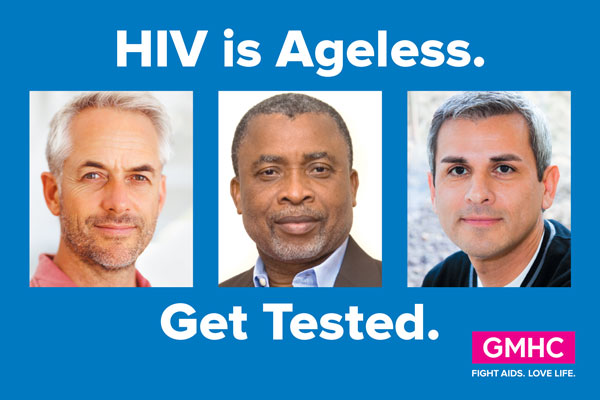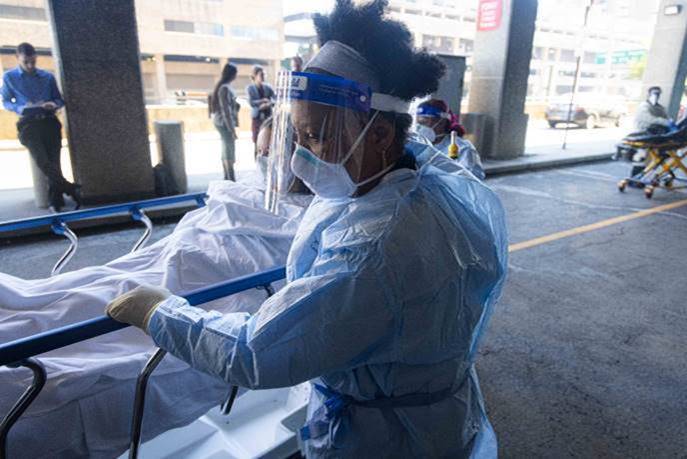
GMHC’s recent testing campaign (“HIV is Ageless”) targeted older gay men.
BY PERRY N. HALKITIS, PhD, MS, MPH | The United Sates population is aging. Because of increases in life expectancy attributable to the advances in public health and medical treatments, Baby Boomers — those born between 1946 and 1964 — will constitute approximately one-third of the U.S. population by 2014. Within this group are two growing segments of gay men: The Stonewall Generation (who emerged into adulthood as the gay rights movement of the late 1960s and early 1970s was flourishing) and men like myself — men of the AIDS Generation (who came of age in the late 1970s and early 1980s).
Based on population estimates, some 1.2 to 1.4 million gay men in the United States will soon be age 50 and over — and in New York City, approximately five percent of gay men are in this age range.
Those who work in the field of gerontology, either in research or in practice and service provision, find themselves at an interesting point. Traditional understandings, approaches and services that were developed for aging generations that preceded us may no longer be relevant. We are all grappling to understand this new group of older adults and their needs moving forward. The fact is, we know very little about the behaviors and expectations of aging Baby Boomers, and even less about those within this cohort who are gay men of the Stonewall and AIDS Generations — and only infinitesimal amounts about those gay Boomers who are aging with HIV.
It is the last group that I consider in my upcoming book, “The AIDS Generation.” Complicating matters is the reality that 50 truly is the new 40, and risk behaviors not considered in older adults of previous generations are a very present reality now. For aging gay men, these risk behaviors are those that permeate our entire adult lives — namely, sex and substance use.
The literature clearly supports ongoing sexual activity among heterosexual adults after age 50 and beyond, and a more limited body of work also documents this in gay men — both HIV-positive and HIV-negative. In one such study conducted with a cohort of men in Chicago in the 1990s, it was determined that gay men 60 and older were as likely to engage in unprotected sexual behaviors as those in their 30s — with both groups reporting equivalent levels of multiple sexual partnering. In a South Florida study of men ages 40-94, high rates of unprotected sex were reported, and were most pronounced among those ages 40-59.
Interestingly, among the older men in the Florida study, those ages 60-94 reported meeting their partners in many of the same settings as younger men — namely, the Internet, bars/clubs, bathhouses and backrooms. Much more telling is the fact that men who had fewer emotional conflicts about their sexuality also engaged in more sexual risk. This finding parallels our own work of younger men, ages 18-21, where we have found that those with less internalized homophobia and higher affinity with the gay community are also more likely to engage in risk. For men of all ages, it appears that greater pride in one’s sexuality (a wonderful characteristic) enables gay men to navigate and engage in gay social contexts where sexual adventurism is heightened (such as bars, clubs and bathouses). As a result, this expression of one’s pride perpetuates sexual risk behaviors.
This pattern of sexual risk-taking also exists when we study those older gay men who are HIV-positive. In our own study of club drug-using gay men, locally known as Project BUMPS, we found that the older HIV-positive men reported rates of unprotected anal sex similar to those in their 20s and 30s. In fact, in our most recent study, Project Gold (which studied HIV-positive men ages 50 and over), we found the following rates of unprotected sex in a month’s time: 13 percent reported unprotected anal sex with an HIV-seroconcordant partner, while six percent reported this behavior with a serodiscordant or status-unknown partners.
Risk-taking behaviors are not confined to sex. They also include substance use — which time again and again we have linked to sexual risk-taking behaviors in gay men. In Project Gold, we found use of substances to be evident with 13 percent of the men reporting alcohol intoxication in the month-prior assessment; 38 percent reported use of marijuana; 14 percent reported use of poppers and 26 percent, use of some other illicit drug (such as crystal meth or cocaine).
These findings corroborated our work with club drug users — where we found reliance on substance use by older gay men, albeit reliance on somewhat different drugs than the young men in the study (the older men were more likely to report use of cocaine and meth and the younger men more likely to report use of Ketamine and GHB). In the previously noted South Florida study, drug use was also evidenced among the 60-94 year-olds regardless of serostatus, with 34 percent reporting use of alcohol two hours prior to having sex, 18 percent reporting use of poppers and eight percent, use of marijuana.
This is all to say that older gay men continue to demonstrate health risks. Unfortunately, this segment of our population often goes unnoticed in our health promotion efforts — a situation that must be reversed given this burgeoning segment of the population. In this regard, efforts that are appropriately tailored to this segment of the population must be developed. It is clear that the messages that work for 20 or 30-year-olds will not have the same effectiveness for older gay men who are at a very different stage of development and at very different points in their lives. While behaviors might parallel those of younger men, the conditions and realities of the lives of older gay men are not the same — necessitating an adjustment in how we deliver messages and services to this older generation.
One final thought: Such health promotion efforts for older gay men must extend beyond HIV prevention. There is no denying that the epidemic has compromised the physical, emotional, and social well-being impact on the lives of gay men who are members of the Stonewall Generation and my group, the AIDS Generation. Yet we are resilient, and have managed to come through the darkest moments of this crisis. While there are certainly older men who seroconvert, the odds decrease with age. Thus, health promotion efforts must not focus solely on preventing HIV, but must consider the interplay of all aspects of health — namely, sexual health nested within an overall framework of aging gay men’s health (including mental health to address the trauma we all experienced coming of age in the first two decades of AIDS).
Finally, programming to address the sexual and drug risk behaviors of older gay men must be framed within the context of the myriad of other health conditions that arise as we get older — and build on the resilience we have demonstrated by surviving the plague.
Perry N. Halkitis, PhD, MS, MPH is Professor of Applied Psychology, Public Health (Steinhardt School of Culture, Education and Human Development) and Population Health (Langone School of Medicine), as well as Director of CHIBPS — the Center for Health, Identity, Behavior & Prevention Studies (chibps.org) at New York University. Follow him on Twitter: @DrPNHalkitis. In late 2013, Oxford University Press will publish his book, “The AIDS Generation: Strategies for Survival and Resilience.”



































